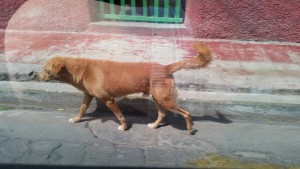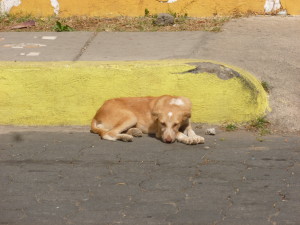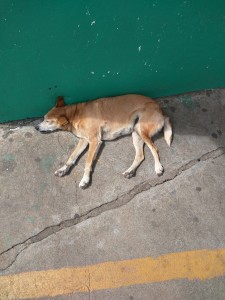 Although Nicaragua shares many of the same features and attractions as other Central American countries — tropical forests, volcanoes, beautiful beaches — it has a singular aspect the other countries do not. While Nicaragua has loads of monkeys, parrots, iguanas, crocodiles, horses, cattle, and goats, it has but one dog. .
Although Nicaragua shares many of the same features and attractions as other Central American countries — tropical forests, volcanoes, beautiful beaches — it has a singular aspect the other countries do not. While Nicaragua has loads of monkeys, parrots, iguanas, crocodiles, horses, cattle, and goats, it has but one dog. .
 Everywhere I traveled regardless of location (Managua, San Juan del Sur, Granada, etc.), this same dog seemed to be following me. It appeared over and over again — a fawn-colored, medium-sized stray mongrel with knowing eyes and a knack for survival. I began to wonder why this dog was apparently following me all over Nicaragua. Was I being stalked by The Hound of the Ortegavilles? He could get around Nicaragua better than I could with a car !!! Each time I spotted him, he had the same coloring, same floppy ears, same size, and was of no discernible known breed. At first, as I walked the various neighborhoods of Managua on my morning jaunts, it was a little spooky. I was certain he was “on the scent.”
Everywhere I traveled regardless of location (Managua, San Juan del Sur, Granada, etc.), this same dog seemed to be following me. It appeared over and over again — a fawn-colored, medium-sized stray mongrel with knowing eyes and a knack for survival. I began to wonder why this dog was apparently following me all over Nicaragua. Was I being stalked by The Hound of the Ortegavilles? He could get around Nicaragua better than I could with a car !!! Each time I spotted him, he had the same coloring, same floppy ears, same size, and was of no discernible known breed. At first, as I walked the various neighborhoods of Managua on my morning jaunts, it was a little spooky. I was certain he was “on the scent.”
 Of course, it turns out that there are many, far too many, stray dogs in Nicaragua and they reproduce like rabbits. The photos included here are a sample of different dogs but they all look alike. Their similarities in appearance suggest they are really “friendly” toward their first cousins, perhaps even brothers and sisters. Most of them appear adequately nourished, but a few were in heart-wrenchingly bad shape. All of them had excellent manners and minded their own business, although they were grateful for the occasional bit of food and pat on the head. We saw virtually no pure breeds anywhere (sadly, no beagles).
Of course, it turns out that there are many, far too many, stray dogs in Nicaragua and they reproduce like rabbits. The photos included here are a sample of different dogs but they all look alike. Their similarities in appearance suggest they are really “friendly” toward their first cousins, perhaps even brothers and sisters. Most of them appear adequately nourished, but a few were in heart-wrenchingly bad shape. All of them had excellent manners and minded their own business, although they were grateful for the occasional bit of food and pat on the head. We saw virtually no pure breeds anywhere (sadly, no beagles).
In Costa Rica, where stray dogs look much like Nicaraguan dogs, a shelter has been established that takes in strays in need of help. Territorio de Zaguates (CLICK ON THE LINK…NICE VIDEO: Land of the Strays), home to some 900 (+/-) strays that roam freely over the expansive refuge. Visitors are welcome to stop by any time to play with the dogs. And, if you are lucky enough to be chosen by one of the dogs, you will be allowed to adopt it (not the other way around!).
Nicaragua’s domestic animals, as well as many of its people, struggle to subsist as best they can on the limited resources available to them. It would be wonderful to hear that an attempt has been started, as it has in Costa Rica, to provide some aid for Nicaragua’s many domesticated animals in need of adequate food and kinder treatment — dogs and horses, in particular.
For all its natural beauty, Nicaragua is a country whose poverty can break your heart.
